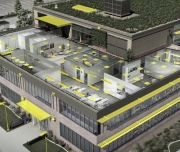System Impacts
Financial Impact
When employing sustainable lighting strategies, financial benefits can be realized from several sources including energy savings from proper controls, efficient equipment and behavioral change, as well as increased productivity and reduced maintenance costs.
For a high-level overview, watch DOE Better Buildings' The Business Case for High-Performance Buildings.
Findings and Case Studies
Finding: LED downlight lamps for existing CFL ballasts can produce energy savings between 40-50%, matching light levels and quality, and have a payback of under 3 years. Source: GSA's Proving Ground | LED Downlight Lamps for CFL Fixtures
Finding: Savings of over 30% is possible in just one year.
Scope: 245 Buildings in the 2011 National Building Competition Source: EnergyStar.gov | National Building Competition: 2011 Summary
Finding: Occupancy sensors can save 15% to 20% on lighting energy costs. Source: ASHRAE.org | Advanced Energy Design Guide for Small to Medium Office Buildings
Finding: One lighting upgrade at a postal sorting facility in Reno, Nevada led to a 6% increase in worker output and a reduction in sorting errors.
Scope: Mail-processing center in Reno, Nevada Source: Rocky Mountain Institute | Romm, Jospeph J. and Browning, William D. “Greening the Building and the Bottom Line” (1994)
Did You Know?
Improvements in indoor environments are estimated to save $17-48 billion in total health gains and $20-160 billion in worker performance.
Courtesy: E Source; data from Right Light Consortium
According to the Right Light Consortium, salaries and benefits account for nearly 86% of annual operating costs per square foot in a typical office space. As a result, even small improvements in worker productivity or reductions in worker absenteeism can lead to significant financial gains, with only a 1% productivity savings offsetting a company’s entire annual energy cost.
Be sure to buy LEDs from the DesignLights Consortium (DLC) Qualified Products List. DLC qualified LEDs provide the most lifecycle cost effective lighting available.

